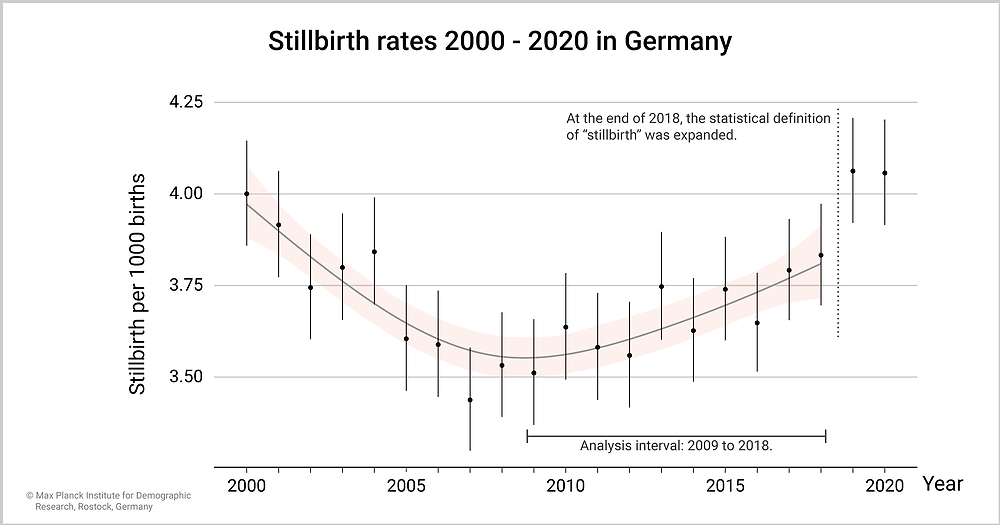July 24, 2023 | News | New Publication
Searching for Reasons for the Rise in Stillbirth Rates in Germany
The stillbirth rate in Germany has been rising steadily since 2009. The reasons for this are still unclear. Researchers at the Max Planck Institute for Demographic Research (MPIDR) and the University of Rostock have used decomposition analysis to investigate the influence of demographic factors such as the age and nationality of pregnant women on the increase in the stillbirth rate in Germany.
While the stillbirth rate decreased from 4.0 to just under 3.5 between 2000 and 2008, a steady increase has been observed since 2009 to 3.8 in 2018. "In our current study, we investigated whether this increase is due to structural changes in the population and whether there are correlations with the age and nationality of those giving birth," explains Maxi Kniffka, researcher and doctoral student at MPIDR.

© MPIDR
The data evaluated comes from the birth statistics of the Federal Statistical Office and the Federal Health Reporting System. "Using a decomposition analysis, we decomposed the increase in the stillbirth rate between 2009 and 2018 into a structural effect and a mortality effect," says Kniffka. A decomposition analysis looks at what part of the increase in the stillbirth rate is due to a change in mortality in the population being studied, and what part is due to a change in the population itself - for example, an increase in higher-risk pregnancies.
In 2018, the stillbirth rate was highest among pregnant women younger than 20 and older than 40. The lowest stillbirth rates were among women who gave birth between the ages of 25 and 34. The stillbirth rate among birth mothers with non-German citizenship was 19.8 percent higher than among birth mothers with German citizenship in 2018. Between 2009 and 2018, the stillbirth rate increased by about 0.75 percent per year. It increased most among birth mothers with non-German citizenship.
The decomposition analysis showed that the stillbirth rate would actually have decreased as a result of the change in age structure. By contrast, examination of the change in mortality within age groups shows that the rate would have increased even more than observed. The increased proportion of non-German pregnant women caused only a very small rise in the stillbirth rate. Thus, most of the growth in the stillbirth rate in Germany was due to increased fetal mortality. "The reasons for the increase in the stillbirth rate in Germany go beyond the obvious demographic changes. More research is needed to understand why fetal mortality has increased," says Maxi Kniffka.
Original Publication
Kniffka, M.S., Rau, R., Kühn, M., Schöley, J., Nitsche, N.: Rising Stillbirth Rates in Germany. Influence of structural changes in the population. German Medical Journal (2023).https://www.aerzteblatt.de/int/archive/article/232767
Authors and Institutions
Maxi Stella Kniffka, University of Rostock; Max Planck Institute for Demographic Research, Rostock
Roland Rau, University of Rostock; Max Planck Institute for Demographic Research, Rostock
Mine Kühn, Max Planck Institute for Demographic Research, Rostock, Germany
Jonas Schöley, Max Planck Institute for Demographic Research, Rostock, Germany
Natalie Nitsche, Max Planck Institute for Demographic Research, Rostock; Goethe University Frankfurt, Germany